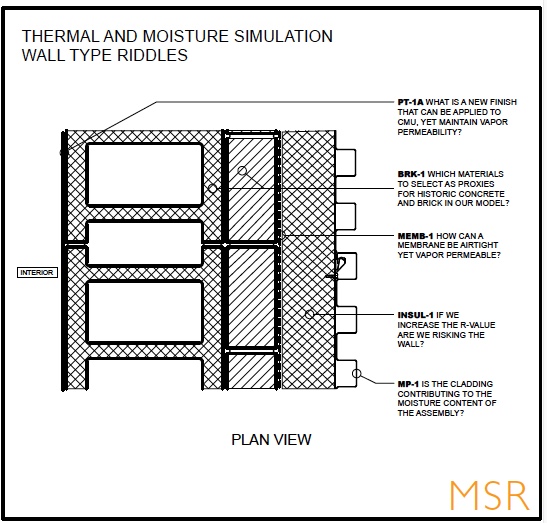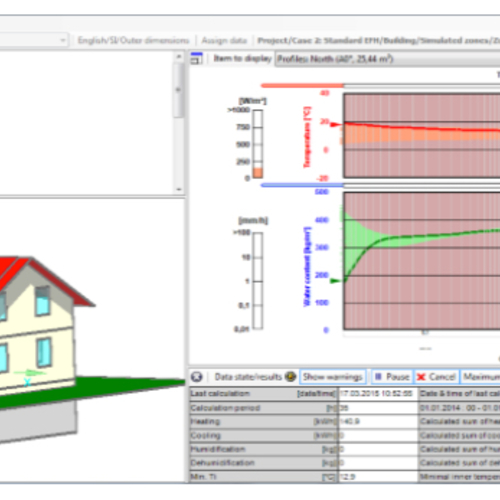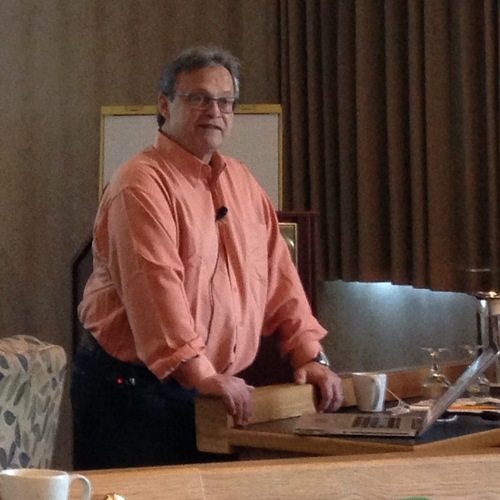
Thermodynamics drive every aspect of living and non-living systems, including building envelopes. Our designs are constantly affected by moisture and heat. The effects of rain, sun, breathing, bathing, and cooking accumulate, and when envelopes fail the fallout is expensive and heart-wrenching.
As a result, architects spend a lot of time trying to understand thermal and moisture performance of building assemblies and the likelihood that these variables might add up to catastrophe.
What better way to understand than to model buildings using simulation software? That was my thought as I approached my six-week, office-sponsored research project in which I attempted to integrate thermal and moisture simulation into our design process workflow. Although various people in our firm have used thermal and moisture modeling on previous projects, this was the first time we made a concerted effort to analyze a tool’s potential for use as a standard on all projects.
The outcome? I’m no longer certain that a simulation approach makes sense as standard practice for the majority of projects or practicing architects. However, architects and architecture firms constantly renewing their building science knowledge will make all buildings better. And if you or your office are thinking of taking on the hygrothermal modeling challenge, I have some advice to help you manage your expectations.
An office research initiative
My investigation was selected as an office-sponsored research initiative. I selected the simulation tool WUFI Pro (Wärme und Feuchte Instationär or “heat and moisture transfer”), German software with a powerful number-crunching ability and an engineer-friendly interface, to test on a series of ongoing projects.
WUFI is capable of simulating the accumulation and dissipation of moisture within building materials over a period of years. The software generates graphs to indicate whether temperature and relative humidity within an assembly are likely to reach dangerous mold-germinating or rot-inducing levels during the simulation period.
I budgeted a week of time to learn the software and four weeks to test a variety of assemblies, and the remaining time to have my results reviewed by colleagues and a building envelope professional.
I tested assemblies on eight different projects, with varying results. Varying, in that the tool itself is not hard to use, but I spent several unanticipated weeks after learning the software trying to understand what the model output was telling me.
In fact, the challenging part of a complex tool like WUFI Pro is not getting the simulation to run, it’s understanding how to read the output, and learning when it can be trusted. My three pieces of advice for prospective modelers are the following:
- You had better be interested in building science. You’ll be reading and expanding your background knowledge quite a bit to be able to understand the variables.
- There’s more to it than selecting the basic materials to create a wall or roof assembly. Other critical modeling considerations include additional heat and moisture loads at key layers in the assembly to account for infiltration, and correctly setting the indoor and outdoor climate variables.
- You’ll want to hone the art of interpreting results. One way to interpret results is by comparing the moisture profile generated by WUFI to ASHRAE 160, Section 6.1, Conditions Necessary to Minimize Mold Growth. Creating a graphic report that will be meaningful to a design team is a study all its own. I learned that it is not helpful to place a graph in front of the team and tell it that the wall they have designed won’t work. After all, if you are on the design team, you’re probably doing this exercise so you can make a solid recommendation on what will work.
Simulation case studies in project workflow
My conclusions about the use of simulation software are best summarized through two case studies. The first was a wall assembly for the renovation of a single-story uninsulated concrete block structure in Minnesota into a commercial office space.
The renovation required the addition of exterior insulation, and the design called for new metal panel cladding and painting the exposed concrete block on the interior. The design team had selected a fluid-applied air-and-vapor-impermeable membrane to be applied to the exterior-facing side of the concrete block wall, which would then be covered by 4 inches of mineral board and metal panel cladding attached with thermally broken clips.
I built the assembly in WUFI and ran a number of different scenarios with different orientations and proxy materials for products that were not in the WUFI database. I found an alarming pattern: In winter, moisture levels inside the weather barrier were climbing to near-dangerous levels for triggering mold, and depending on the properties I assigned to the concrete block, the assembly was getting wetter instead of drying over time.
After controlling for computational errors (the software) and modeling errors (mine), I determined the issue might in fact be real: the vapor-tight membrane was going to cause a problem if the wall was constructed as designed. I tested a number of membrane permeabilities, and found that air-tight, yet vapor-permeable membranes did not have the same failure in simulation.

My findings were corroborated by a building envelope consultant, and as a result, we switched our specification to a vapor-permeable product. It felt like a win for the research project and the entire design team was able to learn from the findings. However, not all test cases proved as useful.
The second example was a proposed roof assembly for a new apartment building, also in Minnesota. The roof was a wooden truss system supporting plywood sheathing, tapered polyisocyanurate insulation board and a watertight roof membrane. Between the trusses, to meet fire code, the roof cavity would be filled with blown cellulose, held in by a fire-resistive vapor barrier and the ceiling finished with painted gypsum board.
The short version is that very few of my 40+ variations of this WUFI model showed favorable outcomes with this roof, even though this is a common multifamily roof construction, and multiple parties including a building envelope consultant assured our team that if we used this roof, it can and would perform satisfactorily.
The conflict between what the model was telling me and what experience and advisors were saying was frustrating. Was it modeling error or computational error? Or was the simulation in fact accurate, and the building industry is overlooking something critical in the design of these types of roofs? Only a forensic investigation could tell.
Based on the previous experience of the owner, this roof probably will be built as planned, although the team is now considering alternatives.
Limitations of simulation and managing expectations
The second case study was a reality check about the potential limitations of practicing architects and their sporadic use of thermal and moisture modeling to predict whether a particular assembly will last. When your assembly appears to be failing in simulation, current simulation tools will not tell you why it is failing or how to improve your design. Simulation involves tricky software with a lot of variables. To get the hang of it takes a couple days, but to get good at it takes weeks or months of practice, which may be difficult to reconcile with a project schedule and budget.
What’s more, some experts note that tools like WUFI only test vapor drive and bulk water at a one-dimensional point in the hypothetical center of a wall or roof. Since it cannot take into account variables such as convection of air within a room, or the behavior of air and moisture at corners, critical factors impacting performance and failure may be glossed over in a simulation approach.
That said, some thermal and moisture modeling may be beneficial even without deep expertise, as long as you understand the limitations. Here are some reasonable (and unreasonable) expectations to be had from modeling with WUFI Pro:
- It is useful for a basic comparison of different assemblies in a given scenario, and determining whether some are likely to be better than others. In other words, it will tell the design team something about relative performance, as opposed to predicting absolute success or failure of an assembly. It will not tell you that you have a “good wall” versus “failing wall,” but it will enable you to make an interpretation more along the lines of “this assembly is likely to be a better or worse wall for this climate, assuming construction matches the design intent.”
- It will provide an understanding of what layers are likely to be most problematic or prone to moisture so you can make sure your details are properly drawn to accommodate.
Practical building science
Simulation is not the only way to understand the performance of an envelope design. If your ultimate goal is to design projects and assemblies that will perform decade after decade, and meet the AIA 2030 Commitment to design only net-zero-energy buildings by 2030, a better approach would be for staff to log some monthly hours learning about the building science principles the software tools are designed to test in the first place.
Prioritize building science in your office’s continuing education. For example, did you know water molecules are smaller than air molecules? That means a weather barrier can be air-sealed, but moisture permeable, a notion that may be counterintuitive at first. Did you know that airborne moisture blown in through a gap or poorly designed detail in the exterior cladding — or a poorly designed vent above a stove or shower — can carry one hundred times more moisture into the walls and roof in a day than will ever diffuse through a membrane?
Develop basic principles instead of standard walls
A key observation from the research project is that it’s not necessary or best practice to design a completely unique wall section for every project. Different aesthetic drivers and weather conditions may lead a design team to select different materials for the walls and roof of different projects, but the enclosure design can still follow a well-researched set of principles tailored to heat, cold, and moisture management needs of the local climate.
Following this research, part two of my project will include the development of a set of robust typical wall, roof, and floor assemblies to be used as starting points in the different climates in which we work. These basic assemblies can be customized for use on many different projects. There is no need to re-simulate every wall on every building.
When in doubt, it is worthwhile to hire a building enclosure consultant to review and help you understand the potential weak spots of a design. We will hire a trusted consultant to review our work in developing typical assembly templates. On a project with unique conditions, feel free to dive into simulation, armed with your regularly refreshed trove of building science knowledge.
But in the end, if you have any question, you will probably save money both in time spent modeling and time spent puzzling over mysterious results by hiring a consultant you trust, or two consultants for a second opinion, to tell you whether the envelope you have designed will perform as intended and how it can be improved.
Simona Fischer is a sustainable design specialist with MSR. She holds a master’s degree in architecture, and a master’s degree in sustainable design in architecture.
Weekly Newsletter
Get building science and energy efficiency advice, plus special offers, in your inbox.















10 Comments
Closing the gap between WUFI results and reality is an important need.
> mold...the vapor-tight membrane was going to cause a problem...
Congrats on going beyond "with external insulation, interior vapor won't condense so it's a good wall".
> very few of my 40+ variations of this WUFI model showed favorable outcomes with this roof
For both cases, It would be interesting to know more details (exact design, climate, etc) and when/where WUFI indicated a problem.
"In winter, moisture levels inside the weather barrier were climbing to near-dangerous levels for triggering mold, and depending on the properties I assigned to the concrete block, the assembly was getting wetter instead of drying over time."
Was the impermeable weather barrier simulated even something that would be damaged by mold?
The concrete can tolerate fairly high levels of moisture without damage, but at some point the vapor pressure might cause the interior side paint to fail if insufficiently permeable.
Simona,
Thanks for this article. Here's my understanding: When WUFI results match the expectations of the person using the software, the user exclaims, "What a wonderful tool WUFI is!"
When WUFI results don't match the user's expectations, the user says, "My inputs must be wrong," and therefore tweaks the inputs until the desired results are obtained.
Some tool!
Simona--thanks for this article and sharing your experiences. But I have a few items that I definitely need to push back on. As background--I've been working for Building Science Corporation (i.e., Joe Lstiburek Inc.) since the 1990s, and have been beating my head against WUFI since the early 2000s, including a chunk of time working with John Straube and Chris Schumacher (now with RDH).
When somebody tells me that the "perfect wall" is showing dangerous moisture accumulation in a Minnesota climate with an interior condition that isn't a freezer storage area, it has me scratching my head. More on the perfect wall (all exterior insulation) here:
BSI-001: The Perfect Wall
https://buildingscience.com/documents/insights/bsi-001-the-perfect-wall
When people ask me "have you run a hygrothermal analysis on the perfect wall," my usual response is that it is a bit like asking a physicist to demonstrate that round wheels work. Pretty well proven by field experience and first principles, although possibly intellectually interesting.
I wonder if one of the issues you're facing is that you're using the ASHRAE Standard 160 Section 6.1 criteria. The research community has known this for a while: using these criteria tell you that walls which work fine in the field (i.e., reality) fail the ASHRAE criteria. Lois Arena of Steven Winter, and Samuel Glass of Forest Products Laboratories--among others--have been fighting this fight. Here is a presentation Sam put together on this topic:
https://web.ornl.gov/sci/buildings/2016/docs/presentations/workshops/workshop-5/Workshop5_Glass_pt1.pdf
Instead, ASTM is currently shifting away from the mold criteria used in Standard 160-2009, and switching to the European Viitanen mold index. Here is the paper Sam put together on this proposed change (I'm a coauthor, but claim minimal credit):
Analysis of Improved Criteria for Mold Growth in ASHRAE Standard 160 by Comparison with Field Observations
https://www.researchgate.net/publication/320352326_Analysis_of_Improved_Criteria_for_Mold_Growth_in_ASHRAE_Standard_160_by_Comparison_with_Field_Observations
Also, for completeness, here's Joe's current thoughts on WUFI--the web page includes links to two Building America (DOE-funded) papers on how we would recommend tweaking WUFI inputs to provide more useful results.
BSI-089: WUFI*—Barking Up the Wrong Tree?
https://buildingscience.com/documents/building-science-insights-newsletters/bsi-089-wufi%E2%80%94barking-wrong-tree
Lastly--an issue with: "For example, did you know water molecules are smaller than air molecules? That means a weather barrier can be air-sealed, but moisture permeable, a notion that may be counterintuitive at first."
I'm wondering if this might be a misinterpretation of some other phenomenon. Air barrier/water-resistive barrier but vapor open materials (i.e., think housewrap) function because *liquid* water forms clusters of molecules (25 to 75 of them) that cannot pass through the microscopic holes. See this column, where Joe refers to basketballs and golf balls:
BSI-066: Holes and Leaks
https://buildingscience.com/documents/insights/bsi-066-holes-and-leaks
So liquid water is stopped, but water *vapor* (individual molecules) passes through. So what about air (N2/O2)? Remember--materials like housewraps have air permeances that are measurably non-zero... but cut airflow down low enough that they qualify as air barrier materials (under 0.02 l/(s-m2)@75 Pa). So any air molecules that pass through, well, don't really matter.
Kohta,
Thanks for your very thorough comments.
If any GBA readers are interested in more information on how the ASHRAE 160 method of describing indoor conditions tripped up a WUFI modeling exercise by Lois Arena and Pallavi Mantha, see my article, "WUFI Is Driving Me Crazy."
Using WUFI *and* experience to create more conservative designs (ie, both support it) makes sense. It's very common to see "For the same cost, I can do x or y. Both are reported to work, but which is better?".
Case 1 above is interesting in that it's similar to Lstiburek's "best wall that we know how to construct" - which specifies a Class I vapor retarder. Apparently WUFI simulations and a strong recommendation disagree here. Would love to see an explanation.
If "always accurate" was a requirement, most prescriptive, experience based designs would have been thrown out long ago.
Elsewhere I've elaborated on what I think is going on with tools such as WUFI. There's something deeper going on here—a very human need to understand complex phenomena, coupled with a cultural belief in the sanctity of calculation. When we build high-performance buildings with elaborate envelopes and use products such as smart membranes the question should not be "will it work?", but rather "how can we design this so that it's reasonably far from failure?". In the right hands, tools like WUFI can answer the latter question easily and definitively. But the apparent precision on offer, as Simona, Kohta, and Martin have pointed out, as well as over-reliance on consultants, can also blind us to the need to increase the understanding of elementary building science principles among everyone in the building industry.
Trans / Jonathan,
Thanks for your observations. A similar process is occurring these days with GPS technology. People navigating in a strange city stare at their cell phone, which tells them when to turn right and when to turn left. After doing this for a week, they are still lost in the new city they are visiting.
An old-fashioned visitor looks around for landmarks, and in a day or two has mastered the major streets and can navigate on her own.
Until they hit an unusual situation (say a traffic jam or accident). Then they wish they had used the modern technology.
There is also "I've been using this route for a week, not realizing there was a shorter/faster route".
I would typically recommend against that ceiling roof assembly like you describe because it doesn't sound like there's provision for at least 1 direction of vapor diffusion drying - which combined with wood and blown cellulose adds up to a potentially bad scenario.
Great article though.
Understanding basic science and established construction practices is more valuable and beneficial than learning a new computer tool...but new computer tools can help us.
Thanks
Log in or create an account to post a comment.
Sign up Log in